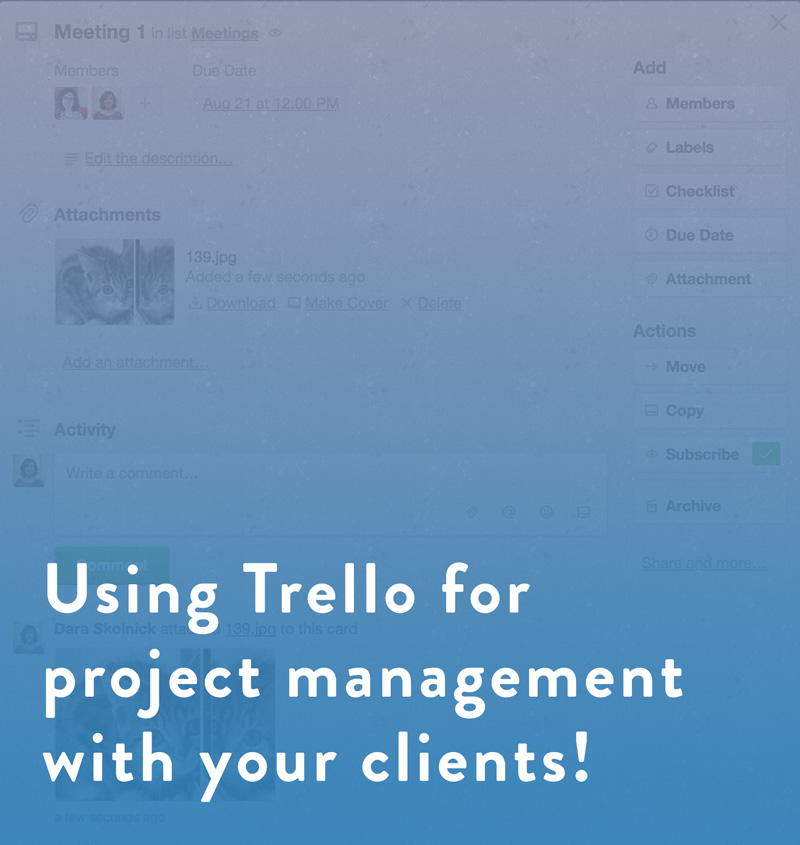
Wow, that title is super exciting and captivating, isn’t it? Maybe I should have called it “She tried using Trello for project management… and you won’t believe what happened next!” I really do find topics about building systems to be really interesting, though, and if you’re here, you probably do too!
If you run a service-based business like I do, it’s very likely that you’ve either heard about or tried a project management system. If you haven’t, let me introduce you to the idea. Project management systems, as the name suggests, keep information about a project (including communication, deadlines, to-do lists and documents) in one place. It’s a way better alternative to running a project out of your inbox, which often looks like having dozens of email threads going back and forth between you and your client, sending a bunch of email reminders to your clients when tasks are due, and searching frantically for the right thread with the information or attachment that you’re looking for. When you have all of your communication and information in one place, it makes both your life and your client’s life easier and helps to keep your project running smoothly.
There are lots of project management systems out there, and they come at a variety of price points. You may have heard of Trello, which is getting increasingly popular because it’s free and really flexible. The idea behind Trello is based on a Kanban system, which, if I’m being honest, I hadn’t heard of before I started using Trello. Shh, don’t tell anyone. Moving right along, the default Trello setup consists of three lists – To Do, Doing, and Done.

The default board layout
Each item in the list is called a “card”, and clicking on each card reveals details about the card that include the due date, label, messages, and file uploads. That will look something like this:
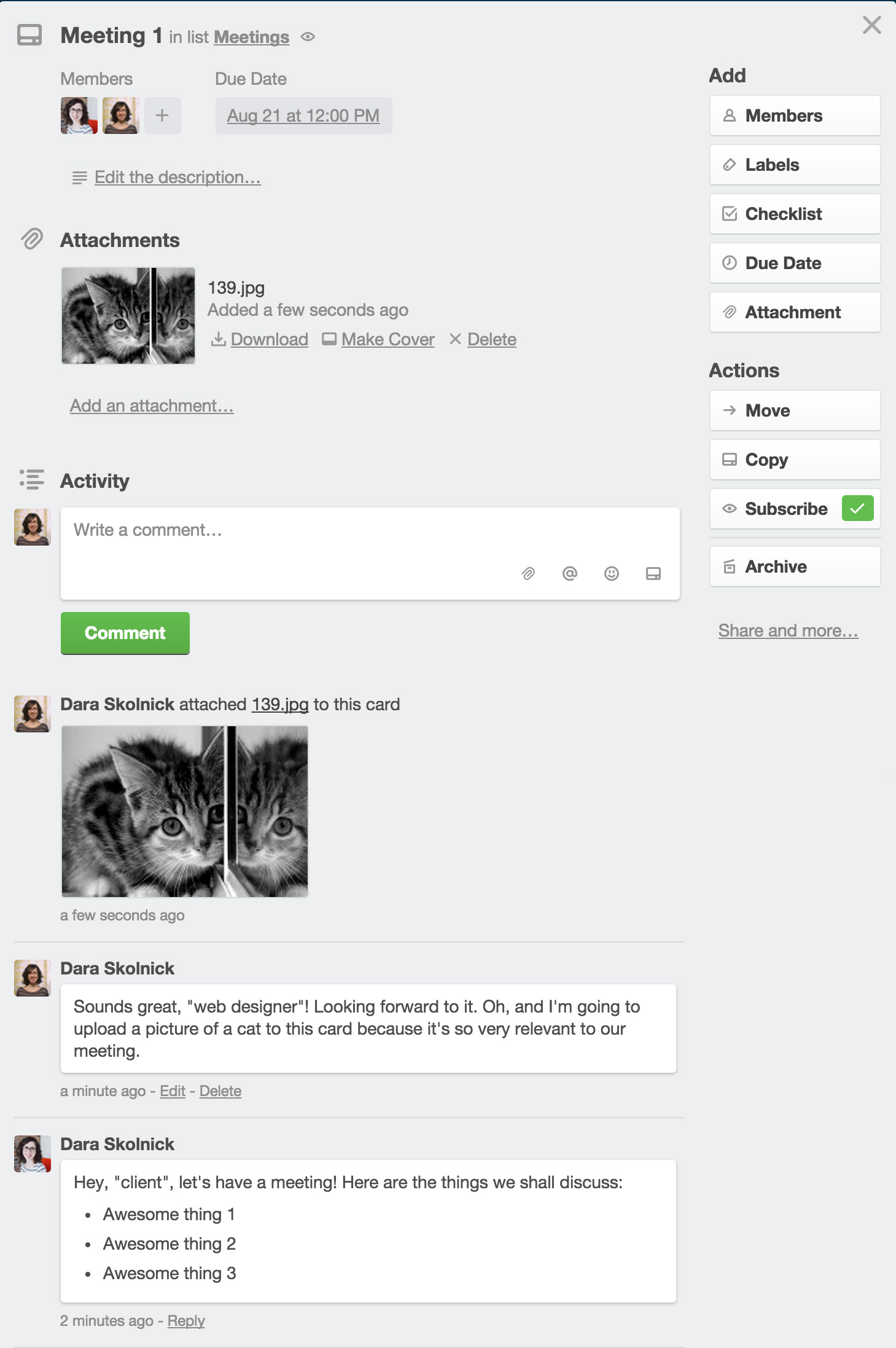
This is definitely a screenshot from a real project. Definitely.
Though Trello has a default list setup, you can actually set up the lists in any way that you want. However, complete freedom can be a little overwhelming, so you can do a quick Google search and find lots of examples of how people use Trello.
One thing I noticed, though, is that most of the examples online are about using Trello internally (i.e. people within a company using Trello to keep their own projects on track, or people using Trello by themselves). While this is great and a very common use case, what I couldn’t find were many examples of how to use Trello collaboratively with your client, who may or may not be used to using project management systems at all. So, I got creative and figured it out! Here’s what I came up with:
Board layout ideas
The great and terrible thing about Trello is that it’s super flexible, which can make it hard to think about how to set it up in an organized way that will work for both you and your client. Here are a few ideas about how you can organize your boards:
With a very simple project, you could break it down as simply as your to-dos, the client’s to-dos, and, optionally, what’s done. This is good for short projects that aren’t broken down into lots of phases. Here’s what that might look like:
Your to-dos, Client’s to-dos, Done
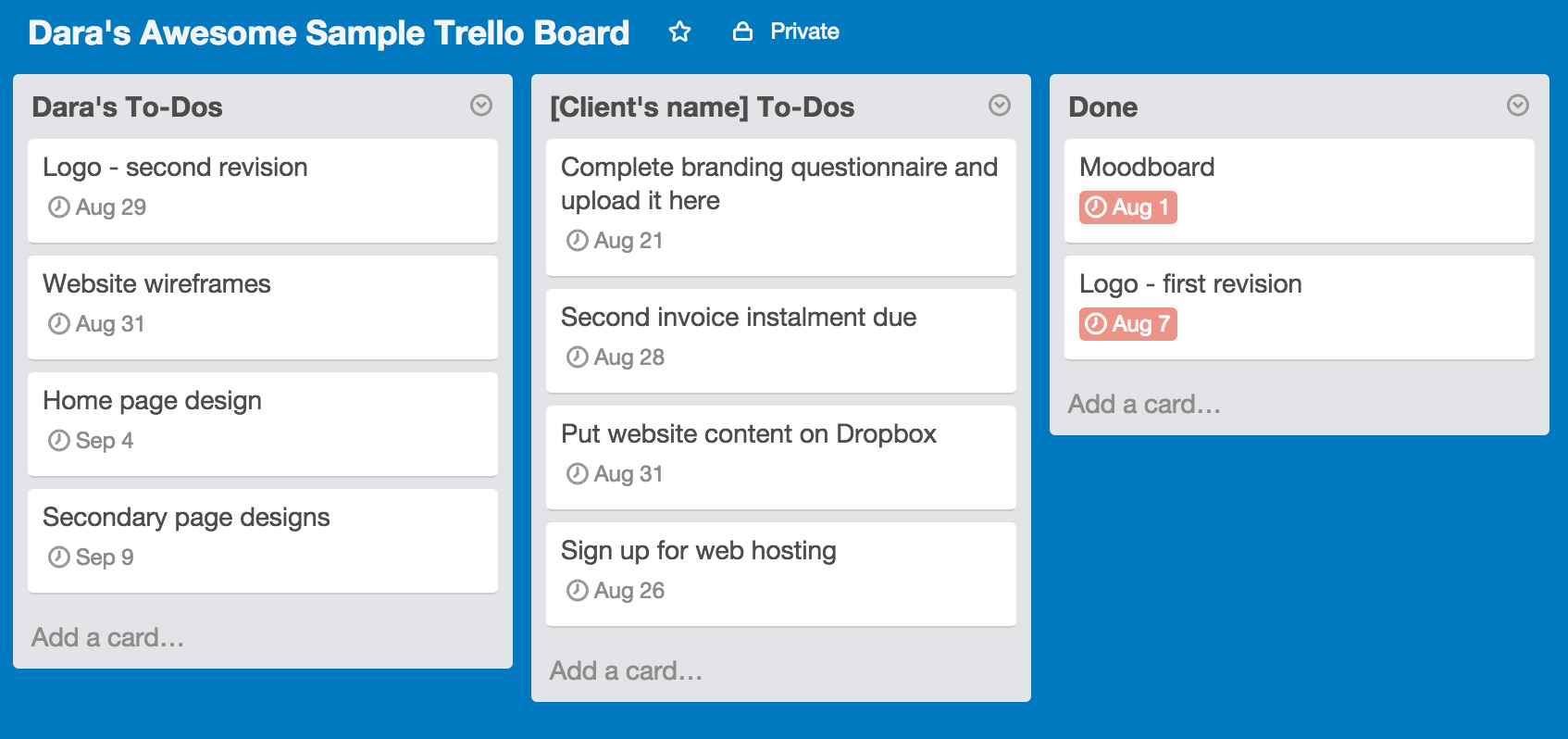
More complex projects, however, could get kind of crazy in this format. You don’t want your lists to be 100 items long, because that would be terrible. I mostly prefer to break my boards down by phase instead, which looks more like this:
Project stages
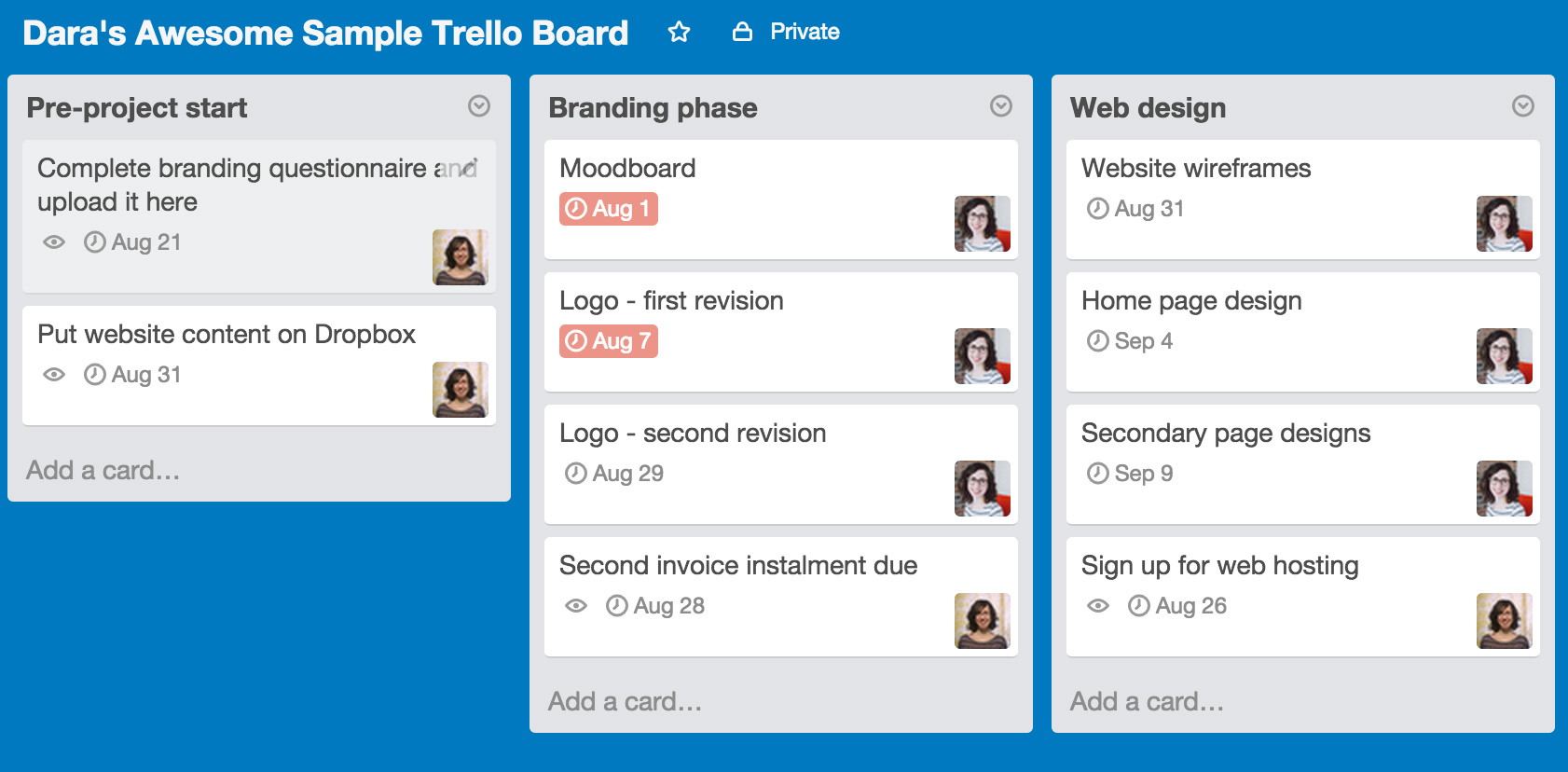
You can also create a “Done” list and drag items there as they’re done, or you can leave them in place if you prefer to see the project in phases throughout. You’ll notice that each item is tagged with a specific person (both of which are me, but let’s just pretend that they’re two different people, with the yellow background me being the client). This helps you keep track of which item belongs to which person, which is super helpful (but much more helpful in real life when they’re not both you).
Or, you can combine approaches! Sometimes I’ll use the project phases for my parts of the project (since I’m the designer/developer and am doing the majority of the work) and then have a separate list for the client’s to-dos, to keep them in a separate, easy-to-find spot.
In addition, you might consider the following lists:
Project Phase overview
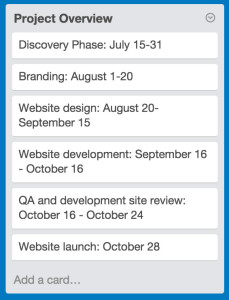
This isn’t a functional list but in a larger project it can be nice as an overview on a larger project so you and the client have an at-a-glance view of the project.
Project Documents/Uploads
You might also create an area where you/the client can share documents, images, and other helpful information. You can create cards for specific items (“Upload images here”, “Upload copy here”, that kind of thing). Or, you might have a shared Dropbox or Google Drive folder and not need this.
Meetings

If you have lots of meetings throughout a project, you might want to create a list just for meetings, and then you can add the meeting agenda and/or meeting notes to the card. Handy! You’ll also see that I tagged both myself and “the client”, which means we’ll both get a useful notification to remind us both that the meeting is coming up soon.
Using labels effectively
One of Trello’s nice features is being able to label items by colour. Just like the list structuring, the labelling feature is extremely flexible, which means that you might wonder what to actually use it for.
When I’m organizing the lists by project phase, I like to create colourful labels for “To Do”, “In Progress” and “Completed”. Then we get to keep the project phase lists in tact and also get to see the status of each item. That looks something like this:
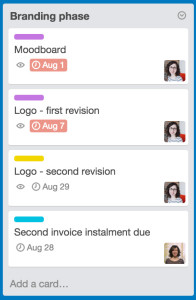
You can name each label, which then shows up when you click on the item:

And then if you want to go the extra step, you can create a Legend list to remind yourself and your client what these colours actually mean! I usually leave this as the last list since other lists are more important.
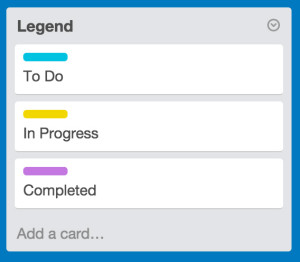
You can really use the labels in any way that you want, so go nuts, friends.
Setting deadlines and using the calendar
One of my favourite parts of using project management software is that it will bug clients on your behalf when things are due. Instead of having to send repeated emails to tell your client that something is due soon, you can get Trello to do it for you! It feels less personal that way (it’s not you bugging them, it’s the software) and it’s less work.
You can set a deadline on each item, and then in the list view you can see, at a glance, when everything is due. This is great because it gives you and your client visual feedback on when something’s due soon or overdue. If you’ve tagged your client (more on that later), they’ll get an email notification a few days before the deadline to remind them that the task is due soon.
But did you know that Trello also has a calendar, and that you can view all your deadlines in whatever calendar software you use? For some reason, Trello hides this awesomeness, so I’ll show you how to get it.
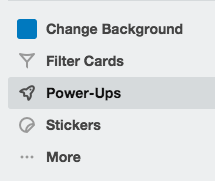
First, in the right hand menu, click on “Power-Ups”
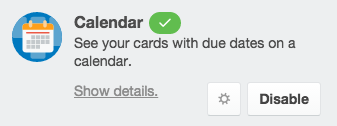
Then, find the Calendar and click “Enable”.
Then, you get a pretty calendar view of the entire project that lists all tasks by date, which is super convenient and might even be an easier way to view the project than the card/list view.
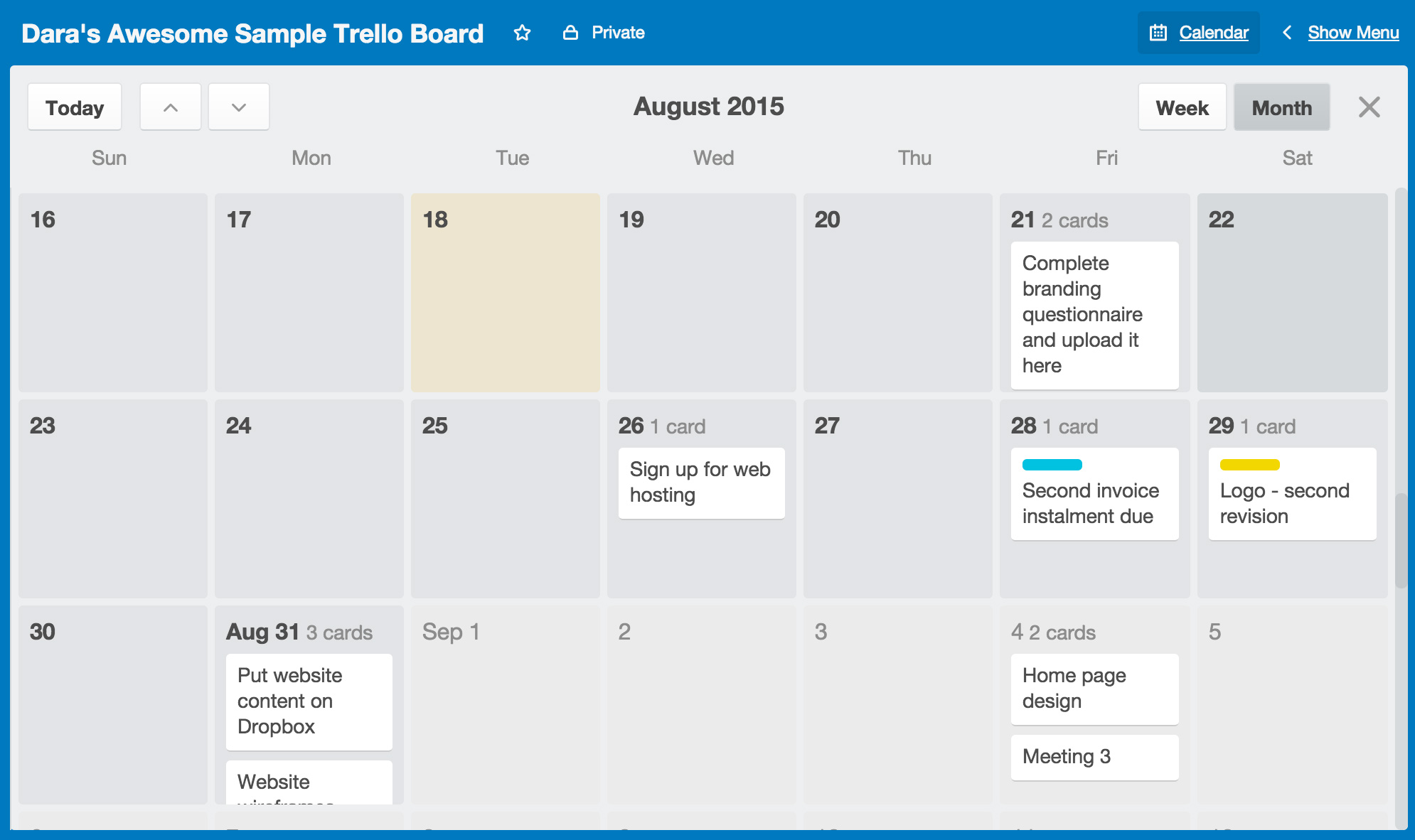
But wait… there’s more. You can even get your deadlines to show up in the calendar you already use.
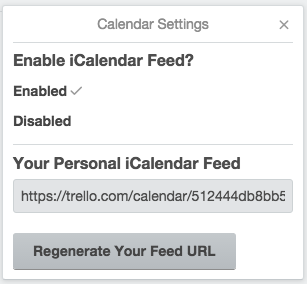
Click on the settings cogwheel and then enable the calendar feed
You’ll want to either subscribe to the calendar feed using an app like Apple’s Calendar or a web-based calendar like Google Calendar. Magic!
You can also just view the calendar on Trello itself, which is nice because you can then click on the cards to see the card detail view right from the calendar.
Make sure to tag the client… and yourself!
Remember when I said that Trello (or any good project management system) is awesome because it automatically sends reminders when deadlines are coming up? This only happens if you tag them for those specific items.
This is a good thing – if you have, say, 42 people working on a project (which probably isn’t the case for you or me, but hey, it could happen), you don’t want everyone receiving notifications about things that don’t even relate to them.
So, make sure to tag clients on items that concern them. Otherwise they won’t receive any notifications and they might not know that the item is even happening/is due soon, and then what’s the point?
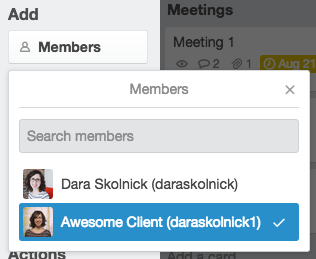
And while you’re at it, be sure to tag yourself as well if you want to be notified about activity on the item! Even if the item is strictly a client to-do (say, uploading content or paying an invoice), if you don’t tag yourself, you won’t be notified if they write a message on that card, which means that you can accidentally miss something unless you’re logging into Trello all the time.
There are really so many ways to use Trello and this is just the tip of the iceberg. I hope you found this helpful! If you organize your boards in a completely different way or use features that I didn’t even talk about, feel free to share what you do in the comments. I’d love to hear about it!
P.S. If you’re not already a Trello user and want to sign up, feel free to do so through my recommendation link. It’s not really an affiliate link since I don’t get any money, but I do get a month of “Trello Gold”, which lets you do stuff like set custom background pictures, and who doesn’t like setting custom background pictures.
Yesss love seeing how someone else uses trello for clients. ::gold star::
High five :D I’d love to see how you use it too!
This is so interesting! I’ve been toying with the idea of setting up a project managment system for clients and knew of asana (and basecamp too, but I’d like to try a free version first) but hadn’t thought about Trello! Pinning this to come back to when I’m ready to give it a try!
Awesome! I hope it works well when you give it a try!
Hi Dara !
Thanks for your useful article !, I use Trello a lot, personal and for customer projects, I will put un practice your ideas.
Hi Felix, glad you found it useful!
Wow, great take on that ! I have been a user of Trello but never really felt in-tuned to the system. I love how you take us through it all and yes that sample image “definitely” seems like out of a real project (wink) I am sure of it! Ha! Jokes apart, this is a nice different perspective from my view of Trello. for some odd reason, I used to end up all chaotic on Trello.
Hey, glad you liked it! It took me a while to get into a good rhythm using Trello – it’s so open-ended that it’s really easy to go off the rails if you don’t have a system. The flexibility is both a good and bad thing!
This is great Dara, I’ve been looking for Trello use-cases with clients for a while now! Thank you! I wonder, have you ever used Trello where 3 parties are involved e.g. the client, an agency, and yourself? Where there might be particular parts of the project that you don’t want one of the other 2 parties to see e.g. meeting notes between yourself and the client, where the agency wasn’t involved, or, notes to your internal team that you don’t want the client to see. I’ve been trying to figure out if Trello could be used effectively in this situation (without creating heaps of separate boards and extra overhead) or whether another tool could do a better job. Would love to hear people’s thoughts!
Hi Michelle! You can definitely use Trello with multiple parties, *but* everything on a board is viewable to everyone who’s been invited to that board. There aren’t per-item privacy settings as far as I know. You’d either want to create two boards (maybe between you and the agency, and then another between all 3 parties) or use another solution! I think Basecamp has privacy settings that might work for this kind of setup.
I found this very useful, thank you! I also found that it’s important to not put anything that you do not want others to see on the card level. I think this is such an important feature. In fact, i’ve emailed the CEO and got a respose from them–
“The new version of Business Class doesn’t have per-list or -card permissions—currently, you can still only add people at the board level. I’ll pass your interest on to our team for consideration—let me know if there’s any additional info you’d like for me to pass their way.
If you’re curious about how our team decides on what requests we work on, this article gives some insight into that process: http://help.trello.com/article/724-submitting-feature-requests-for-trello”
If my team is also using trello, I can have them power up as well so it integrates with their calendars? I was a little hazy on where to find my ical/google cal url. But I would like for them to be able to do this. I have paid for the business class, as I wanted to support their organization.
This was a really interesting read because I use Trello for internal management, but not yet with my clients!
I was worried that they may not understand it well or that they just might not like signing up for another service… but perhaps I’ve been putting too much thought into it and should’ve just tested it :)
I use lists and labels completely different in internal management (for me a label means “technique” or “context” ie. Design, Drawing, Writing, Errands, Communication…) but I see how in this setting labels might be better used for status.
Very cool, and thank you so much for sharing a bit of your inside process!
Hi Nela, it’s definitely worth trying! I used Trello for years before trying it out with clients, and although there’s always a little adjustment at first (especially if they’re not used to project management software), it’s worked out pretty well so far! I also use a different board/labelling system internally so I totally get where you’re coming from there.
We have been using Trello with our clients for quite some time. Most of our clients were immediately hooked up and they are using it for other projects of their own, not only ours. They like it because it’s easy to use, highly intuitive, very visual, and the mobile client is at least as good as the web version.
We also developed a time tracking tool for Trello and it is also nice that the client can clearly see what is happening, how much we worked on a feature or request or bugfix, how much we will charge them at the end of the month or end of projects.
You can track your time with Time for Trello (timefortrello.com) without having to install anything (we are lperforming a facelift at the moment). It even works with official Trello mobile applications – this is unique at the moment.
Looks great but a bit complicated. I had to read twice every idea :) Only a part about colorful labels was easy – I always use this function (we use Worksection instead of Trello but it’s similar in it) :))))
Never tried trello only used only proofhub and basecamp for my projects. After reading your post I think I will give trello a go as well. Good work though.
You told me about Trello months ago and I took a cursory look at it but haven’t dug in. Your overview on how to use this as a collaborative PM tool is great. Thanks for sharing!
I recently started using Trello for project management and have been struggling with how to differentiate completed cards from open cards. Like you, I set up each project as a board with a list for each project stage and didn’t want to move cards out of their stages onto a “Done” list. Love your suggestion of using labels to track the progress of each card! Don’t know why I didn’t think of that myself.
Love this article! I’ve been using Trello on and off since last year but couldn’t figure out how to use it for client work. I found a video on YouTube that gave some of the tips that you have and then I decided to research more.
I love using the labels for statuses and love the legend idea too. The linking to other email applications is pretty cool too.
I understand that if you subscribe to the entire board, you’ll get notifications for all activities.
Thanks again
LOVE! As you mentioned, I was able to find lots of instances of people using Trello with internal teams and very few of people doing client communication with it. I’m getting ready to try it and love your suggestions. Thanks!
Very helpful, thanks for sharing !
The ideas of using it with client for project management is awesome. The power up to use calendar as well as suggestion to insert time line is simply amazing. Thanks for sharing.
Love it. Thank you!
So true that the flexibility is a double-edged sword. You have to be open to adjusting your layout depending on the situation.
I’m revisiting my client onboarding process, and have been searching for an inexpensive (okay, free) solution. I kept seeing Trello pop up as a project management tool, but couldn’t figure out how to use it for client communication. Your article is great, thank you!
Thanks! Just THE intro i needed!
Pingback: How to Use Trello to Work With Clients
Oh finally! I was searching for some project management tool to use with my design & web clients and your article is gold! I have heart about Trello before but now I’m definitely gonna give it a SERIOUS TRY :)
Thanks again!
Oh, and I used your link so you can have a cute background ;)
Awesome, so glad you found it helpful, Claudia! (And thanks :D Cute backgrounds will be mine! haha)
Very good information. Lucky me I ran across your site by accident (stumbleupon).
I’ve bookmarked it for later!
Just starting out in Trello, so this is very helpful. One nice functionality I noticed – if you single-click a label (the color bar) on a card, all labels will expand to show the label text. I keep the text on on all my boards – makes the labels much easier to use in my opinion.